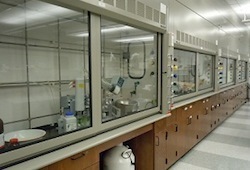
An efficiency retrofit currently being installed in the Jordan Hall teaching labs will enable faculty to save $45,000 annually, simply by pressing a button.
“Fume hoods draw large volumes of air up and out of a building in order to protect researchers from breathing harmful chemicals,” explained Bob Werner, a Mechanical Engineer in the Utilities Department who is overseeing the project. “Modern hoods draw less air as you close them, but even when fully closed, the draw is still significant. That’s important in a research lab, where experiments may be running overnight, but it’s unnecessary in teaching labs such as we have in Jordan. It’s during the nights and weekends that we plan to save energy, utilizing a set-back mode that reduces that minimum flow.”
The set–back mode will be activated by the last faculty member to use the lab each day. By pressing a button near the door, the minimum flow in the hoods will drop from 240 to 90 cubic feet per minute. The fume hoods must be closed in order for the set-back mode to take effect, and they instantly return to normal operation when they are opened in the morning.
“The reason that fume hoods use so much energy is that the air in laboratories can’t be recirculated for safety reasons,” explained Rachel Novick, Education and Outreach Program Manager in the Office of Sustainability. “All that air being exhausted from the fume hoods has to be replaced by outside air, which has to be heated or cooled and humidified or dehumidified, depending on the season.”
The set–back mode is being installed on 158 hoods in Jordan Hall and will reduce the University’s carbon dioxide emissions by approximately 711 tons per year, the equivalent of taking 123 automobiles off the road. The $45,000 in annual energy savings is expected to repay the cost of the retrofit in about six and a half years.
“Students and researchers on campus can save even more energy,” added Novick, “by keeping their hoods at the proper working height, about 12 inches, when they’re at their hoods, and closing them whenever they step away, even for a minute.”
Written by the Office of Sustainability